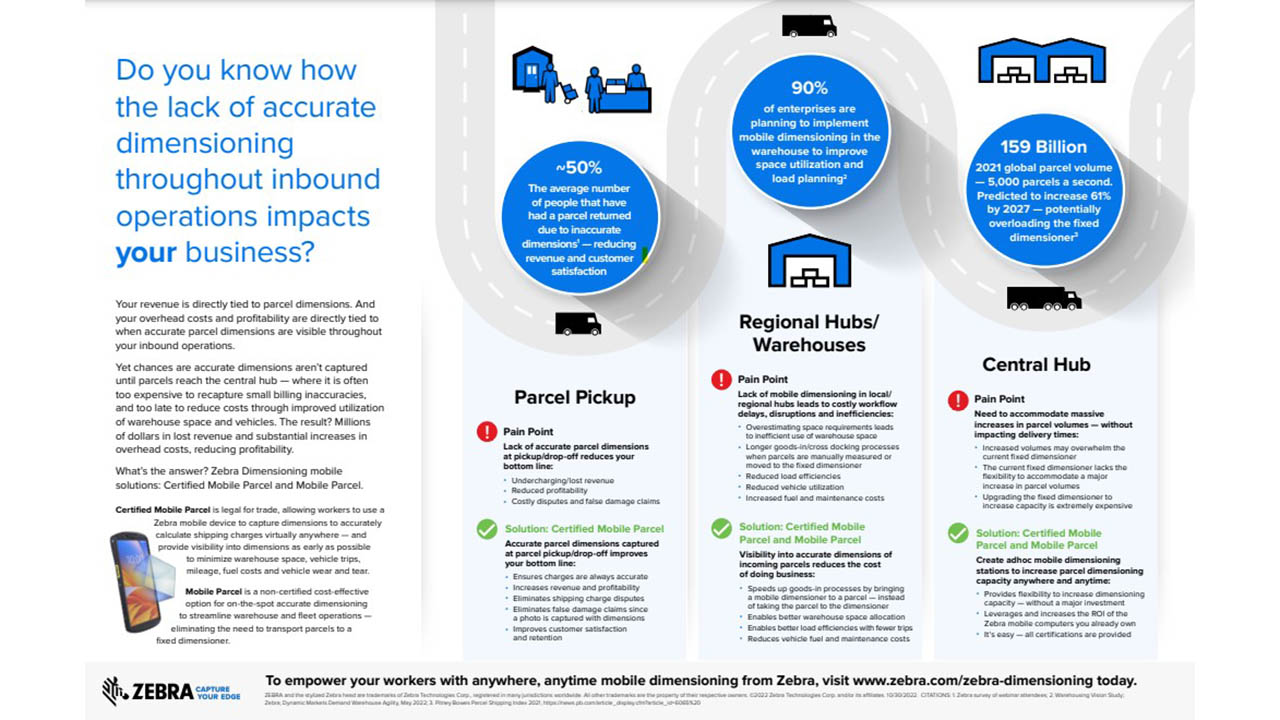
Everyone in the Shipping Chain Stands to Benefit from Mobile Dimensioning. Here’s Why.
If your teams carry around a measuring tape to get package or parcel dimensions, it probably takes them at least two or three seconds to figure out the length, width and height, right? (If they’re efficient.) Now, I would imagine it takes at least a few more seconds to write down those measurements or punch them into a computer. So, let’s just say, at best, one employee can process one package every 10 seconds if they have the process down pat. In the world of speedy logistics and exploding package volume, this is a problem.
Though they’re moving fast, they’re not moving fast enough.
The latest figures from the annual Pitney Bowes Parcel Shipping Index show that 59 million parcels were generated in the U.S. alone each day in 2021. That equates to about 683 new parcels getting picked up or dropped off each second! Though global stats haven’t been released for 2021 yet, this single country view paints the picture of how painstaking the shipping process can become if the right information isn’t captured – and the right charges aren’t applied – at the time a package is first processed.
If it’s taking your employees more than a few seconds to capture parcel dimensions and calculate shipping charges, your entire company – and shipping chain – will underperform financially and fall behind operationally. And once you fall behind, you’re going to spend all day catching up. Pickup routes will take longer to complete. Lines will get longer (and the number of customer complaints will grow) at retail or commercial drop-off points. And it's possible some packages won’t make it on the forward-distribution trailer or container before the doors close. That means recipients will get delay notices, which is never a good thing.
That’s why mobile dimensioning technology is going to become table stakes for everyone who touches packages along the shipping chain. It lets you bring the dimensioning system to the package, versus having to move the package to a dimensioning system every time.
The Business Case in Warehouses, Depots, Hubs and Distribution Centers
According to feedback received in Zebra’s latest Global Warehousing Vision Study, 1 in 5 warehouse operators are already using mobile dimensioning technology in some capacity, and it’s the number one sensor technology investment expected for the next 12 months. Over one-third of warehouse operators say they plan to roll it out within a year, and, within five years, 90% say they will be leveraging mobile dimensioning.
Now, you might be wondering why warehouse operators, who have large facilities and the space for fixed dimensioning systems, would opt for mobile dimensioning instead of just strategically installing fixed scanners throughout the building.
Though the study didn’t ask specifically, mobile dimensioning has suddenly become a top priority, nearly two-thirds of warehouse operators admit they’re struggling to fulfill the increased volume of e-commerce orders they’re receiving. Warehouse operators now say outbound packing, staging and loading is one of their biggest challenges, and they’re having a hard time improving their order fulfillment processing times. So, I would imagine they value any technology tool or process change that can help teams get orders packed, staged, loaded and out the door faster, which mobile dimensioning can. Though fixed dimensioning systems are certainly faster than manual measuring tape methods, they still require someone to bring boxes to the sensor. That’s time that can be saved by giving employees mobile computers that have time of flight sensors and dimensioning software built in and fully integrated with back-end logistics systems.
In fact, I suspect everyone who manages a depot, hub or distribution center (DC) in the shipping chain would be eager to minimize the movements of workers and packages with a mobile dimensioning solution that is as readily available as a mobile app and as easy to use as a handheld barcode scanner. Though these types of facilities are typically just a stop in a package’s journey – not the point of entry into the shipping chain – they are equally overwhelmed with orders and limited on space. They need to ensure they have room for everything they’re going to receive and forward. Plus, the only way to avoid shipping air is to have a solid load plan, and that’s only possible if you are building the plan using confirmed package dimensions, captured as early as possible in the process.
The Move to an All-In-One Mobile Dimensioning-Mobile Computing Solution in Field and Retail Environments
I’m seeing more postal companies and shipping carriers motivated to move to mobile dimensioning outside the four walls as the number of door pickup requests rise. Returns are burgeoning, as are online consignment sales and e-commerce transactions overall. With free package pickup now a standard service in many places, it’s critical that parcel carriers have a way to collect or validate payments at the time of pickup. If they’re just grabbing the box and putting it on the truck, it could be hours before it gets to a place where charges can be calculated and payment confirmed. That could lead to package delays or returns to sender if payment needs to be rendered before package forwarding is allowed.
Likewise, if those managing retail or post office collection points are relying on a measuring tape to get dimensions, any number of miscalculations (and financial losses) could occur. Their measurements may not be precise, or they may accidentally type in the wrong dimensions to the shipping charge calculator. As a result, the customer could be under- or overcharged, and the wrong information could be sent to logistics planners.
Of course, fixed dimensioning systems could be installed at some brick-and-mortar locations if the footprint allows, but they may still be too large to allow for installation at each workstation. That means workers will have to move each package to the fixed dimensioner to get an accurate measurement, which takes time. And they may have to wait in line to use the shared dimensioner, which takes even more time. Plus, fixed dimensioning systems may be cost-prohibitive for smaller retail drop points or those run by franchisees. And with consumers increasingly going to pop-up kiosks in retail and convenience stores to drop off returns, fixed dimensioning systems just aren’t going to be physically or financially feasible. So, the only way to mitigate the risk of financial losses or poorly managed shipping chains is to make the move to certified mobile dimensioning systems.
The Takeaway
It’s counterproductive to have anyone lug packages to a fixed dimensioning system to get a certifiable shipping rate, especially regular, cuboid parcels, and it’s risky to manually intake packages using a measuring tape. The odds of a wrong measurement or miscalculated shipping charge are just too high, and you can’t afford margin erosion or customer overcharges right now. Both will hurt your bottom line, the latter from lost customer loyalty and time-consuming settlement efforts. So, if you think you’re ‘all set’ with the fixed dimensioning system or manual process you have in place today, I strongly recommend you audit how much time or money you’re really saving – or losing – with your current process. Then seriously consider investing in a certified mobile parcel dimensioning solution.
Just be sure you look at each mobile dimensioning option objectively and with a critical eye. As I noted in my last post, not all mobile dimensioning technologies are certified legal for trade, reliable for use in the field, or going to be super cost efficient or easy to manage.
Yes, you need mobile dimensioning capabilities if you touch packages for any reason. But you need the right mobile dimensioning capabilities if you want to speed up shipping-related processes, increase your shipping capacity, and retain more revenue – capabilities you’re not going to find with a point solution.
Your workers need a single mobile computing device that can guide them through their days with the greatest level of efficiency and productivity and take the guesswork out of any calculation-dependent tasks that could slow them down or trip them up, thus leading to a poor performance rating. At the same time, you need to streamline your device fleet as your technology dependency increases. Your workers can’t do their jobs effectively, and you can’t meet customers’ shipping-related needs, if you’re relying on old-school methods for package processing. They must be able to pull out the mobile computer they rely on to do everything else and, with a single button push, get the package’s dimensions – and, if needed, tell the customer their shipping charge. It’s that’s simple.
###
Editor’s Note:
If you’re not yet sold on the value of mobile dimensioning or this is the first time you’re hearing about it, reach out to your local Zebra representative. They can talk to you about it in more detail in the context of your business operations. You should also check out these resources:

You can also download the PDF version of this infographic here.
###
Did You Know?!
Zebra Dimensioning is the only certified solution of its kind that can be legally used for trade in the USA, Canada, Europe and (now) Australia and New Zealand.

Graeme Simons
Graeme Simons is currently Global Product Manager of the Enterprise Mobile Computing portfolio and strategy group at Zebra where he is responsible for category management of the company’s head mounted displays. Graeme also leads the company’s initiatives in enterprise augmented reality (AR).
Graeme has more than 35 years of experience within the IT, mobile communications and consumer electronics industries and has introduced many groundbreaking innovations, including the very first laptop PCs and tablets with market leading manufacturers including Toshiba, NEC, Siemens, Ascom and NCR. He gained considerable international and multi-cultural experience in these roles.
Prior to joining Zebra, he served as Head of PC Product Strategy (EMEA) at Toshiba, where he managed the company’s portfolio of mobile computers, all-in-one PCs and accessories and served on the PC division’s global product strategy board.
Graeme holds a BA (Honours) in Business Studies, majoring in Business Information Systems and International Marketing from Manchester Metropolitan University. Graeme also holds a post graduate diploma in Marketing (Dip.M) from the Chartered Institute of Marketing.




